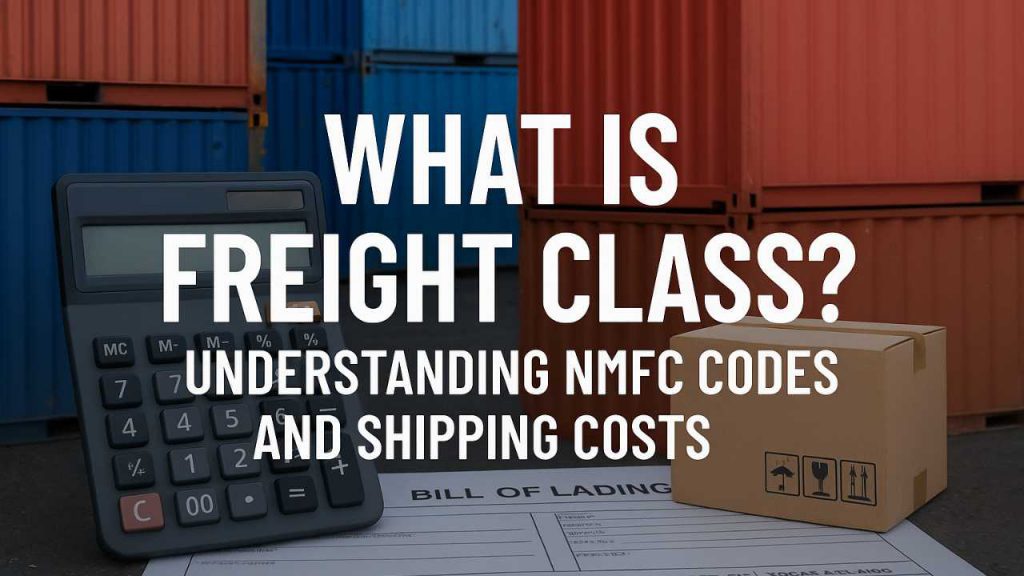In the labyrinthine world of shipping, understanding what freight class is might seem as delightful as rushing into a warehouse without a flashlight. Yet, grasping this concept is vital for anyone intent on untangling shipping costs, especially for supply chain managers and logistics coordinators tasked with budget performance. So, what is freight class, and why does it matter? This crucial classification, set by the National Motor Freight Classification (NMFC) standards, influences pricing and impacts the smooth delivery of your precious cargo.
Imagine sending what you thought was a refrigerator across the country, only to find it reclassified midway, with extra costs tacked on gleefully like surprise toppings on your favorite ice cream. To avoid such shipping snafus, a savvy operation professional must be well-versed in NMFC codes—the unsung heroes dictating what class your freight earns and consequently, the rate you’ll pay. Decoding the nuances of NMFC can feel akin to deciphering the ancient Rosetta Stone, only with more daily relevance to your bottom line.
In this article, we’ll traverse the maze of freight classification, unveiling how NMFC codes are assigned, why accuracy is your wallet’s best friend, and how you can integrate this knowledge into logistics planning—for a more predictable, budget-friendly shipping process. Whether you’re a small business owner, a seasoned executive, or part of a logistics team, understanding freight class is your ticket to sidestepping unwelcome reclass fees and ensuring your shipments stay on course. Let’s not leave your shipping success to chance; let’s classify it right from the start.
What Is Freight Class and Why It Matters
Freight class is a crucial factor in the logistics world that determines shipping rates and influences carrier selection. Established by the National Motor Freight Traffic Association (NMFTA), it categorizes freight by characteristics like weight, dimensions, density, and handling requirements. Because nothing screams “excitement” like differentiating NMFC class 55 from 70, right?
Freight class affects your shipping costs, as carriers utilize these classifications to provide shipping estimates. Misclassifying freight can lead to unexpected surcharges or reclass fees, affecting your budget and supply chain timelines. To make better shipping decisions, it’s essential to understand where your freight falls on the class spectrum.
Here’s a brief look at some common freight classes:
Freight Class | Density (pcf) | Typical Commodities | Cost Impact |
|---|---|---|---|
Class 50 | 50+ | Heavy machinery, bricks | Low |
Class 125 | 6-7 | Furniture | Medium |
Class 500 | Less than 1 | Ping pong balls, pillows | High |
For further assistance in logistics planning, consider teaming up with Hatfield & Associates, a logistics partner committed to optimizing your shipping strategies. To learn more about regulations, visit the National Motor Freight Transport Association.
Who Sets Freight Classes? Understanding the NMFC System
Freight classes are determined through a structured system known as the National Motor Freight Classification (NMFC). This system is overseen by the National Motor Freight Traffic Association (NMFTA), which uses standardized freight class codes to categorize goods based on specific criteria like density, handling, stowability, and liability.
The NMFC system includes multiple freight classes that range from Class 50 to Class 500. Higher classes typically indicate items that are low-density, need special handling, or are fragile—imagine something like feathers being in a higher class, though not as light and fluffy. Lower classes often reflect denser commodities that ship more economically, like bricks or metal hardware.
Here’s a table to illustrate:
Freight Class | Density Range (lbs/cu ft) | Typical Commodities | Cost Impact |
|---|---|---|---|
50 | > 50 | Metal Hardware | Lowest Cost |
125 | 12 – 15 | Refrigerators | Moderate Cost |
300 | 6 – 8 | Wine Bottles | Higher Cost |
500 | < 1 | Feathers (metaphorically) | Highest Cost |
By understanding the NMFC system, businesses can better plan shipping logistics and avoid common misclassification errors, potentially leading to more cost-effective freight rates.
How Freight Class Is Determined
Determining freight class involves four essential factors: density, stowability, handling, and liability. These core metrics ensure that shipments are classified accurately, affecting both pricing and delivery reliability.
Density is paramount. Calculate it by dividing the weight by the cubic feet occupied. For example, a shipment of bricks may be denser than a fluffy teddy bear batch, thus landing it in a different freight class.
Stowability looks at how easily items can be stored with other goods. Items with unusual shapes or hazardous properties might prove tricky roommates in a truckload.
Handling assesses the special care required, like whether goods are hazardous materials needing extra caution.
Finally, liability evaluates potential damage risks. Fragile or perishable items demand cautious handling, thus possibly commanding higher freight classes.
Here’s a relatable scenario: Two seemingly similar chairs might end up in different classes if one is packed in a protective case, affecting density and handling. Misclassification could lead to unexpected surcharges—certainly not what you’d call “fun,” right?
Partnering with experts like Hatfield & Associates can help navigate these classifications, optimizing shipping and reducing costs. For a thorough discussion, explore logistics planning.
Common Freight Classes and What They Mean
Understanding freight class is crucial in the shipping realm for cost-cutting opportunities and productive freight rate negotiations. The National Motor Freight Classification (NMFC) system uses freight classes to standardize pricing among carriers and is a definitive source for aligning shipping costs with commodity types.
Here’s a quick look at common freight classes and their typical commodities:
| Freight Class | Density Range (lb/ft³) | Typical Commodities | Cost Impact |
|---|---|---|---|
Class 50 | Over 50 | Brick, engine blocks | Lowest cost |
Class 70 | 15-22.5 | Car parts, plastics | Moderate cost |
Class 100 | 9-12 | Furniture, machinery | Average cost |
Class 150 | 6-8 | Appliances, bicycles | Higher cost |
Misclassification can lead to significant expenses like unexpected surcharges. Consider the horrifying bill when a single pallet of plastic toys wrongly classified as Class 70 ends up as Class 100!
Proper logistics planning is key to avoiding pitfalls. Hatfield & Associates offers expertise in navigating these complexities, ensuring your freight dances the cost-efficient tango it was meant to. For more on logistics planning, have a look at this guide.
How Incorrect Classification Can Cost You
Misclassifying freight may seem like a minor slip-up, but the repercussions can be anything but minor. Imagine a consignment of lightweight textiles mistakenly classified as heavy machinery — easy oversight, costly outcome. Reclassification fees are the first warning sign; your freight is halted at a terminal, only to be reassessed and charged an additional fee for the oversight.
Next, come delivery delays that wreak havoc on your carefully coordinated logistics schedule. The late delivery of goods can mean lost sales or disappointed customers waiting longer than promised.
Lastly, brace yourself for chargebacks from clients requesting compensation for missed delivery timelines or incorrect invoicing. You’ll feel the pinch as profits shrink.
Common Misclassification Costs
- Reclassification Fees: Charges for reassessing freight class
- Delivery Delays: Extended transit times due to reevaluation
- Chargebacks: Financial penalties from unsatisfied customers
Avoid these pitfalls with precise freight classification. Understanding the ins and outs of freight classes can be a genuine asset when aiming to cut costs and improve your supply chain efficiency. For more in-depth insights, check our guide on logistics planning.
How to Accurately Determine Freight Class
Determining freight class accurately is crucial for managing shipping costs and avoiding pesky reclassification fees. Freight class, assigned through the National Motor Freight Classification (NMFC), is based on product density, stowability, handling, and liability. It ranges from Class 50 to Class 500—lower classes translate to lower shipping costs.
Use precise tools and calculators to measure weight and dimensions, as density is a primary factor. Calculate density by dividing the total weight by cubic feet, and compare it against NMFC guidelines to identify the correct class. Because nothing says ‘fun’ like decoding the difference between class 55 and 70, these measurements need to be spot-on.
Table: Freight Classes & Density Ranges
Freight Class | Density Range (lbs/ft³) | Cost Impact |
|---|---|---|
50 | Over 50 | Lowest cost |
70 | 30 – 35 | Moderate cost |
500 | Less than 1 | Highest cost |
For complexity or confidence in compliance, consider professional logistics support. Companies like Hatfield & Associates can aid in superior logistics planning and freight classification, safeguarding your budget. For comprehensive guidelines, always refer to authoritative sources like the NMFTA.
Where Freight Class Fits into Overall Logistics Planning
In logistics planning, freight class plays a pivotal role, directly impacting transportation management systems (TMS), carrier selection, and cost forecasting. Freight class is a standard that helps categorize commodities based on density, stowability, and other characteristics. By understanding where your shipment fits on the freight class scale — from Class 50 for dense goods to Class 500 for fragile items — you can effectively plan logistics and avoid costly misclassifications.
A well-calibrated freight class influences TMS by offering accurate data for shipment tracking and management. It also assists in selecting carriers that align with cost and service expectations. Accurate classification ensures reliable pricing and reduces unexpected reclass fees. Because nothing enhances a morning like surprises in cost forecasting caused by class mismatches.
Long-term, aligning freight class with logistics planning boosts broader supply chain efficiency. The choice of freight class not only dictates transportation cost but also informs broader decisions within the supply chain, like inventory levels and order fulfillment timelines. For comprehensive guidance, consider consulting experts such as those at Hatfield & Associates for optimizing shipping strategies through precise freight classification. For further expertise, check out this guide to logistics planning.
Final Thoughts: Getting Freight Classification Right from the Start
Accurate freight classification is pivotal for anyone navigating the intricate world of logistics. From reducing freight shipping costs to improving delivery reliability, getting it right from the outset is key. Understanding your freight class doesn’t just enhance operational efficiency—it saves money and avoids those dreaded reclass fees that pop up like unannounced guests.
Here are some quick takeaways:
- Accurate Classification: Always refer to the National Motor Freight Classification guidelines to ensure your commodity is correctly classified.
- Density and Cost: Remember, freight class is influenced by density—higher density often means a lower freight class, thus reducing costs.
- Avoiding Pitfalls: Misclassifying freight can lead to unexpected surcharges. Use tools and partners to assist in correct classification.
By taking a proactive stance on logistics planning, you not only streamline your operations but also position your business to thrive amidst competitive markets. Consider partnering with experts like Hatfield & Associates to leverage their expertise in optimizing freight planning. Remember, a little diligence at the start can lead to significant savings and efficiency gains.
Frequently Asked Questions
Freight class is a standardized classification system established by the National Motor Freight Classification (NMFC) that categorizes shipments based on density, stowability, handling requirements, and liability. Classes range from 50 to 500, with lower classes (dense, easy-to-handle items) costing less to ship than higher classes (lightweight, fragile, or difficult-to-handle items). This system ensures consistent pricing across carriers and helps determine shipping rates, making it crucial for logistics planning and cost management.
Freight classes are determined by the National Motor Freight Traffic Association (NMFTA), which oversees the National Motor Freight Classification (NMFC) system. The NMFTA uses standardized freight class codes to categorize goods based on specific criteria, ensuring consistency across the transportation industry. This organization maintains and updates the classification standards that carriers use to determine shipping rates and handle different types of commodities.
Freight class is determined by four essential factors: density (weight divided by cubic feet), stowability (how easily items can be stored with other goods), handling (special care or equipment required), and liability (risk of damage or theft). Density is the primary factor - calculate it by dividing total weight by cubic feet occupied. Items with higher density typically receive lower freight classes and cost less to ship, while low-density, fragile, or difficult-to-handle items receive higher classes and higher shipping costs.
Common freight classes include Class 50 (dense items like bricks, metal hardware - lowest cost), Class 70 (car parts, plastics - moderate cost), Class 100 (furniture, machinery - average cost), Class 125 (refrigerators - moderate-high cost), Class 150 (appliances, bicycles - higher cost), up to Class 500 (very lightweight items like ping pong balls - highest cost). Lower classes generally mean lower shipping costs, while higher classes result in higher transportation expenses due to space utilization and handling requirements.
Incorrect freight classification can result in significant additional costs including reclassification fees (charges for reassessing freight class), delivery delays (extended transit times due to reevaluation), and chargebacks (financial penalties from unsatisfied customers). When freight is misclassified, carriers may stop shipments at terminals for reassessment, leading to unexpected surcharges and disrupted supply chain timelines. These costs can substantially impact your budget and customer satisfaction, making accurate classification essential for efficient logistics operations.
To ensure accurate freight classification, use precise measuring tools to calculate weight and dimensions accurately, refer to NMFC guidelines for your specific commodity, calculate density by dividing total weight by cubic feet, consider all four factors (density, stowability, handling, liability), and consult with logistics experts when uncertain. Many companies partner with experienced logistics providers who understand NMFC codes and can help avoid costly misclassification errors. Always verify classifications before shipping to prevent reclassification fees and delivery delays.




